Uncategorized
How to Visually Sex Dart Frogs Part II
Part II: Sexing Other Common Dendrobatids
Dart frogs, like many frogs, can be difficult to sex based on outward appearance. Sure, we all know males call and females lay eggs, but how can you tell who is who just by looking at them? The following hints and tips are meant to help you in establishing the sex of your anuran pets.
This is part two of a two part article on visually sexing dart frogs. It focuses on Dendrobates auratus, D. leucomelas, D. truncatus, Phyllobates sp., and Ranitomeya sp. Many of these frogs share characteristics that make sexing them very similar, especially if they have reached sexual maturity.
Sexing Dendrobates auratus. D. leucomelas, and D. truncatus
Auratus, Leucs, and Truncs are all considered part of the “Tinctorius Group”, and are very closely related to Dendrobates tinctorius. However, sexing them is often more difficult. Generally, by 8-10 months, an experienced keeper can make an educated guess. The older the frogs are, the more apparent their sex – by 2 or 3 years, the differences are often very obvious at first glance. Trucs tend to be pretty difficult to visually sex, regardless of age.
- Size: As a general rule, female frogs will be larger than their male counterparts. This assumes that feeding, housing, and age are similar.
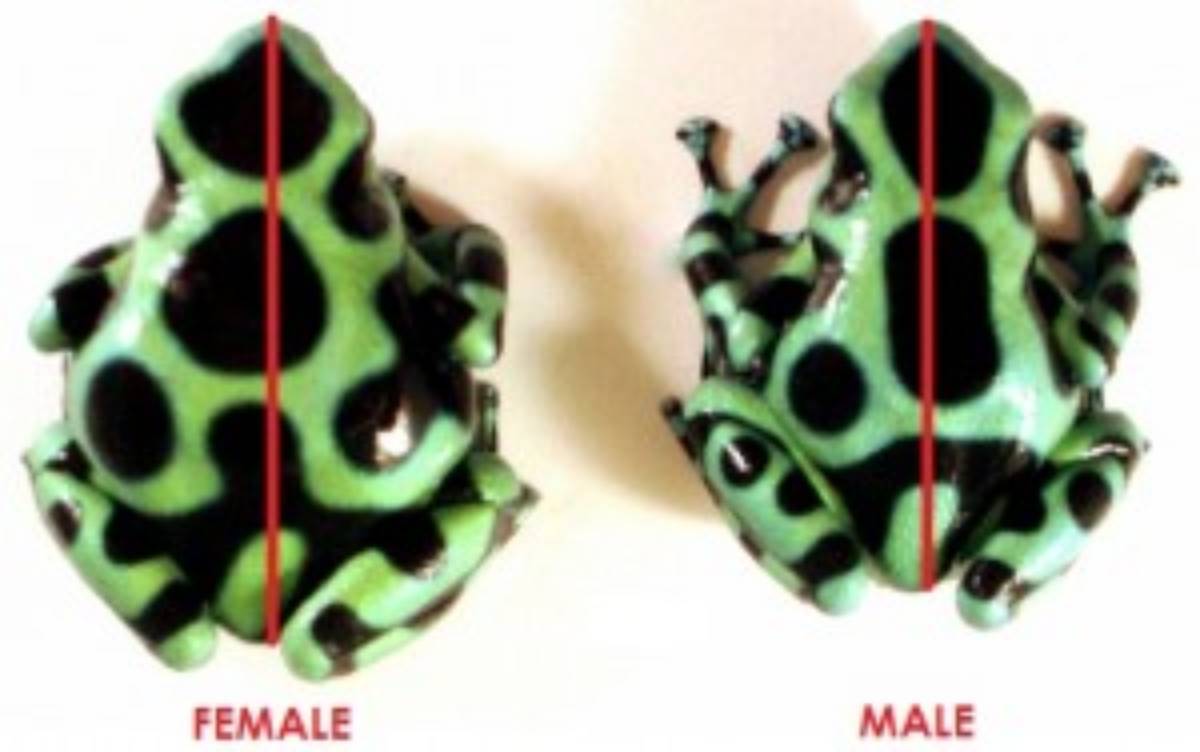
Dendrobates auratus ‘Costa Rican Green and Black’
- Girth: Mature, breeding females generally appear pear shaped because they are carrying eggs. This can be obvious in some frogs, and much more subtle in others. If the frogs are overweight (a common occurrence in the hobby), it may be more difficult to distinguish between the two sexes.
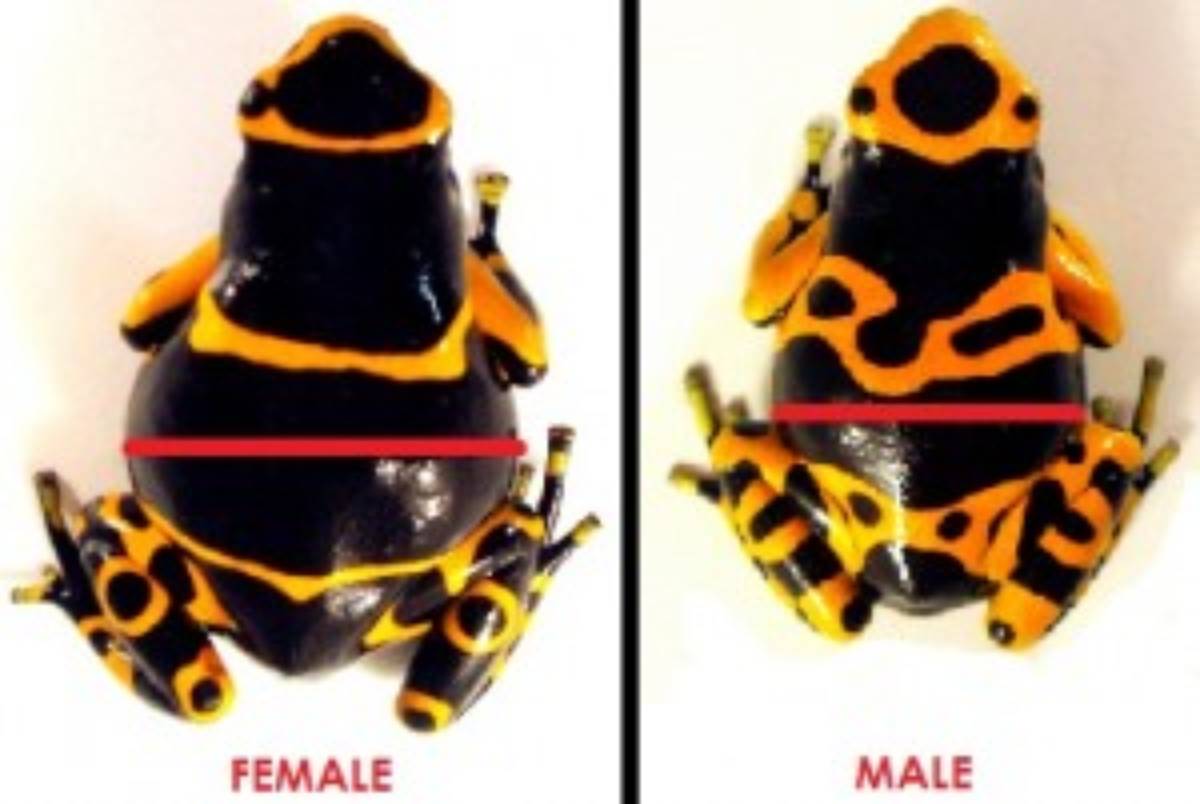
Dendrobates leucomelas ‘British Guyana’
Sexing Phyllobates sp. And Epipedobates sp.
This group includes many popular hobby frogs, such as Phyllobates terribilis, P. bicolor, P. vittatus, and Epipedobates anthonyi. It can be fairly difficult to sex many of the species in these genus, and often times your best bet is to wait for calling or egg laying. After the animals are sufficiently old enough (typically 1-2 years), it’s possible to make an educated guess on sex based on body shape and size. Having a group of individuals to compare to will greatly aid you in your ability to properly sex the animals.
- Size: As a general rule, female frogs will be larger than their male counterparts. This assumes that feeding, housing, and age are similar. Not only are females larger, but they tend to have a wider head, as well. Females also have a more robust, rotund appearance.
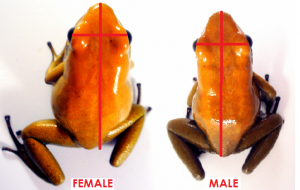
Phyllobates bicolor ‘Gold’
- Girth: Sexually mature females will generally appear wider than males. This can be obvious in some frogs, and much more subtle in others. If the frogs are overweight (a common occurrence in the hobby), it may be much more difficult to distinguish between the two sexes. In my experience, these frogs typically do not develop the ‘pear shape’ evident in many females of other species.
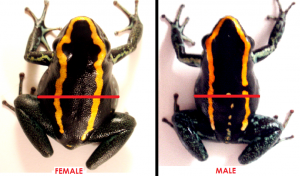
Phyllobates vittatus
Sexing Thumbnail Dart Frogs
Thumbnail Dart Frogs are in the genus Ranitomeya. They are so called due to their diminutive adult size, with many species not exceeding the size of a thumbnail. Being so small would lead you to believe that visual sexing would be more difficult. Luckily, this group of frogs tends to reach sexual maturity at a young age (I’ve had R. ventrimaculata successfully breed as young as 4 months, although breeding at 6-8 months is more common), and show sexual dimorphism at an earlier age than other dendrobatids. When visually sexing thumbnails, there is two basic features that stand out.
- Appearance of body length: Even though female thumbnails tend to be larger, and longer, often males have a lanky, stretched out appearance. This contrasts greatly to the pear shape of a sexually mature female carrying eggs.
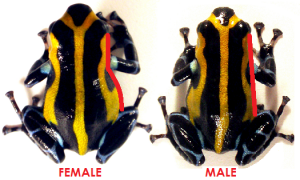
Ranitomeya lamasi ‘Standard/Highland’
- Size: As a general rule, female Ranitomeya sp. will be larger than their male counterparts. This assumes that feeding, housing, and age are similar. This is especially evident when the frogs are in the 4-6 month range.

Ranitomeya ventrimaculata ‘Amazonicus’
Conclusion
Although visually sexing dart frogs is by no means an exact science, by using the presented guidelines along with the experience that will come with time, an experienced dart frog keeper can make accurate predictions on the sex of the animals before they are sexually mature. Most of the time, raising young frogs together in a group will allow for easier selection of pairs (as you have more individuals to compare against each other), as well as presenting a greater chance of getting at least one male and one female.
Next week, we’ll go over some basic information that needs to be considered before bringing home your first dart frogs. We’ll review things such as longevity, diet, temperature requirements, and housing that make dart frogs amazing pets, but not for everyone.
